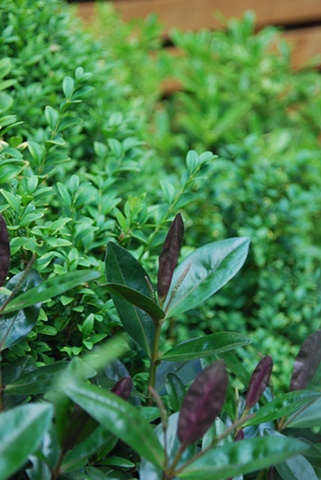Sustainability - Why Bother?

To be sustainable means to use resources that meet our needs but without damaging the environment. For garden designers that translates to using materials whose production does not destroy natural habitat and will cause minimal pollution during their transportation or end use along with reusing materials already on site. Sounds great, but it can be a bit of a minefield. Which is best - cement-based paving produced locally or natural sandstone transported all the way from India? The following are some suggestions for at least moving in the right direction:
• Cut down on cement use by replacing cemented walls with alternatives such as dry-stone or rammed earth walls, turf banks or gabions filled with recycled materials (could include old bricks from existing site).
• Use products that don’t need cement footings such as living willow.
• Replace gravel with bark chippings, shells or recycled products such as glass and rubber.
• Always use wood from sustainable sources - even with FSC approval it is best not to use tropical hardwoods (think of the transportation).
• Buy local – don’t use products that are transported long distances including items such as containers, compost and mulch.
• Try to reuse resources from the existing site - old paving could be used to construct a new soakaway, turf could be stacked to make loam etc.
• Use locally reclaimed products such as timber – and this can be tropical hardwood.
• Purchase plants grown locally – they will grow away more successfully than many grown and imported from warmer climates such as Italy and France.
• Consider the possibility of raising the canopy of mature planting instead of removing and starting again.
• Use low-tech solutions and materials.
• Design to minimise new construction.
• Consider rainwater harvesting.
• Consider green roofs (for buildings such as sheds and outdoor rooms) and green walls (especially suitable for large-scale buildings).
• Choose local contractors who are interested and willing to work with sustainable criteria.
But is any of this enough? Particularly since the rise of tv gardening programmes our private plots have turned into fashion statements with designers picking up on the latest trends no matter what they might be. Some experts feel we will have to rethink our whole attitude to gardens. According to Mark Laurence, one of the country’s foremost experts in sustainable design, we will soon be forced into making huge changes in the way we live our lives. We have already passed the peak of oil production and are poised on the edge of the downward slope. Within the next decade he believes modern intensive agriculture will be unable to cope with the pressures of demand and our back gardens will have to change from simply being a place that is visually pleasing to one that produces our food. If Mark is right we cannot afford to just sit back and take the ‘why bother’ attitude?
Many clients will not have considered how sustainable their new garden might be and it is up to the designer to gently educate (not preach). Designers need to be prepared with solutions that may not previously have been considered by the client, for example designing a fire pit to sit around in the evening (perhaps burning locally produced charcoal) instead of using a gas-guzzling patio heater. Some clients may not particularly care about sustainability, but if designers can create gardens that fit the brief and the budget and just happen to have at least some elements of sustainable design within them, that has to be better than nothing. As it is the client’s garden (and money) it will be up to them if they wish to follow the sustainable route. If they still insist on concrete paving, patio heaters and hardwood decking then unfortunately there is little the designer can do except look to the next project to make a difference.
For more information see www.marklaurence.com and SGD members can find further advice on the Society’s Members’ Page.
© Sharon Brown 13th March 2009
http://www.gardendesignunlimited.co.uk/a/Sustainability-Why-Bother.aspx